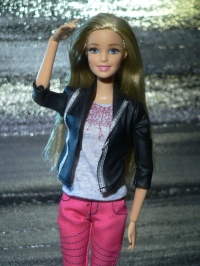By Kwamesha Joseph

The makers of Barbie released a more diverse lineup of dolls that will be in stores starting March 1. Julius Seelbach/Flickr
Women all over the world come in many different shades, shapes and sizes. Now, apparently so does Barbie.
After years of criticism, a new Barbie made her debut on the cover of Time magazine’s February issue. The ‘pleasantly plump’ American icon stood adjacent the caption, “Now can we stop talking about my body?” Mattel recently announced its most radical change yet: the addition of three new body types. Barbie dolls will now be offered in petite, curvy and tall, all of which will stand next to the original doll on toy store shelves beginning on March 1.
The first Barbie dolls arrived on the scene almost 60 years ago courtesy of founders, Ruth and Elliot Handler. Barbie was inspired and named after Ruth’s daughter, Barbara, who seemed to be fascinated with fashion and teenage life. “My whole philosophy of Barbie was that through the doll, the little girl could be anything she wanted to be,” she said. “Barbie always represented the fact that a woman has choices.”
Ironically, a lack of choices seemed to be a large criticism of the brand. While Barbie’s professional resume is extremely lengthy, for many years Barbie was characterized by her blonde or brunette hair, blue eyes and unrealistic body proportions. There were no alternatives for young girls who did not carry those same features. In fact, it was not until about 1980 that Mattel released its first Barbie doll of color. However, even then, the body measurements remained the same.
A 2006 study that was published in the Developmental Psychology journal revealed how much the anatomical impossibility of Barbie dolls affects young girls. The study showed that young women often aspire to be just like Barbie, so the thin body proportions on the dolls have had very negative effects on young girls’ body images. The doll has since been linked to numerous eating disorders and lower self-esteem. For that reason, Barbie dolls caught a lot of media attention and eventually parental concern.
Speaking on this issue, Natalie Erasme, FCRH ’18, said, “Believe it or not, dolls are one of the ways that little girls envision their future. When there is a standard set — in this case by a doll, and you don’t seem to fit that standard, often times it’s hard to set realistic expectations for yourself.”
It seems that traditional standards of beauty have become a thing of the past. Mattel will be adding 33 new dolls to the Barbie collection. The new dolls will be combinations of three new body types, seven new skin tones, 14 new face sculpts, 22 different eye colors and over 40 new hair colors and styles.
“The Barbie dolls are a step in the right direction. Through them, Mattel is showcasing that there is so much more to young women than just one standard of beauty, ” said Matthew Vasquez, FCRH ’18.
Over the past three years, Mattel has been seeing a consistent decline in sales. In October, the company reported that its stock price was down about 43 percent from its peak in 2013. Many believe that these new dolls are by no means an attempt to change the standard of beauty. Mattel, like any good corporation, did what was best for the sales — appeal to a larger audience.
Nicole Guice, senior designer at Mattel, believes that with the release of the new dolls, children will begin “seeing the differences amongst their friends and family being celebrated.” The dolls are starting to reflect what real people look like.
In the midst of numerous social justice reforms, the hype over the new Barbie dolls comes as no surprise. The dolls are seen by many as a symbol of the changing, more inclusive standard of beauty. The new dolls are now available for pre-order on the Barbie website and will appear on store shelves later this Spring.
